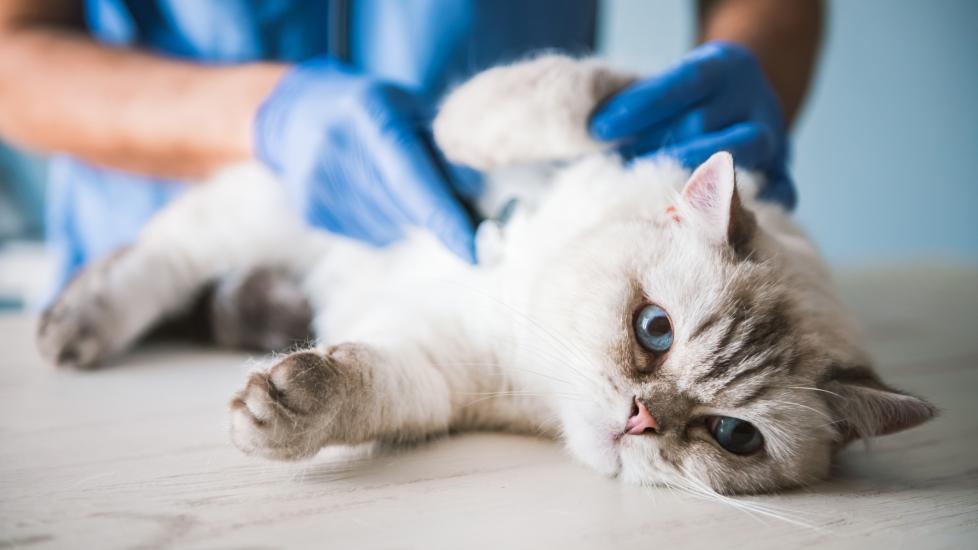How To Perform CPR on a Cat
vadimguzhva/iStock / Getty Images Plus via Getty Images
Emergencies happen. And when they do, cat CPR can be a lifesaving tool. Thankfully, learning how to do CPR on a cat isn’t very difficult. Here’s everything you need to know about CPR for cats.
What Is CPA in Cats?
Before we can get into CPR for cats, we need to address another abbreviation: CPA, which stands for cardiopulmonary arrest. When a cat is suffering from CPA:
-
Their heart is not beating
-
They’re not breathing on their own
-
They lose consciousness
Just before a cat develops CPA, you may notice signs like dilated pupils, abnormal breathing, pale or blue gums, vocalizing, and collapse.
There are many causes of CPA in cats, including:
-
Traumatic injuries
-
Very low blood pressure (shock), which may be caused by severe blood loss, infections, allergic reactions, or drug reactions
-
Conditions affecting the cat’s ability to breathe
-
Abnormal heart rhythms, congestive heart failure, and other forms of heart disease
-
Health problems that lead to severe electrolyte disturbances or metabolic changes
-
The end stage of any serious disease or injury
-
Complications of anesthesia
Without adequate blood flow and oxygen delivery throughout the body (especially to the brain), the cat will die. Someone who knows how to perform cat CPR needs to be able to step in immediately while someone else drives to the vet. While CPR continues, the cat should be taken as quickly as possible to the nearest veterinarian for more advanced care.
If you are alone and an emergency happens, skip CPR and rush your cat to the ER.
What Is Cat CPR?
CPR (cardiopulmonary resuscitation) is a way for a person to partially replace the functions of a cat’s heart and lungs. CPR involves putting pressure on the heart and then releasing the pressure to push blood around the cat’s body. Breathing air into the cat’s lungs increases the amount of oxygen that is in that blood.
However, CPR is not nearly as effective as a cat’s normal heartbeat and breathing.
When To Do Cat CPR
How do you know when a cat needs CPR? Look for four things:
- Loss of consciousness: Make sure the cat is not just sleeping or groggy. Shake them and make some loud noises.
- No breathing: The cat’s chest won’t be moving up and down and you won’t be able to feel air coming out of the cat’s nostrils.
- Clear airway: Check to see if anything is blocking the back of the throat, such as a treat or toy. If you see something, use your finger to sweep from one side to the other to try to dislodge it.
- No heartbeat: Lay your hand on the lower left side of the cat’s chest to check for a heartbeat.
Take only a few seconds to do this evaluation. If you are unsure if the cat has a heartbeat or is breathing, it’s better to start CPR right away.
Delaying CPR when it’s needed will dramatically lower the cat’s chance of survival. When in doubt, one person should start chest compressions and mouth-to-snout breathing while somebody else drives to the nearest veterinary clinic.
How To Perform CPR on Your Cat
1. Lay the Cat on Their Side
Lay the cat on their side on a flat surface. Either side is fine.
2. Begin Chest Compressions
Aim for a rate of 100–120 compressions per minute. Use the song “Stayin’ Alive” by the Bee Gees to help you find the right pace.
You will utilize a one-handed technique to wrap your dominant hand around the breastbone with your thumb directly over the location of the heart and pointed upward to the spine.
Compress the chest by moving your thumb toward the palm of your hand while keeping the thumb parallel with the palm, rather than pinching your thumb and forefinger. Each cat chest compression should reach a depth of one-third to one-half the width of the cat’s chest.
Place your non-dominant hand against the spine to stabilize the cat while you are performing compressions. Since you are using your hand and arm muscles to do these types of compressions, you may need to switch hands if you get tired.
3. Start Giving Breaths
Every 30 chest compressions, stop and give two breaths.
Hold the cat’s mouth shut and straighten their neck so the air can easily travel into the lungs. Cover the cat’s nostrils with your mouth, making a seal with your lips and blow air through their nostrils.
Watch the cat’s chest. It should rise for about a second to about as high as it does during a normal breath.
Remove your mouth and pause for a couple of seconds between the two breaths to let some air leave the cat’s lungs. Resume chest compressions after the second breath.
Delaying CPR when it’s needed will dramatically lower the cat’s chance of survival.
4. Continue the Pattern
Give 30 compressions followed by two breaths, followed by 30 compressions, and continue until the cat becomes alert or a veterinarian can take over their care.
5. Switch People After Two Minutes
Performing CPR on a cat can be exhausting. If possible, switch duties after two minutes.
Transporting Your Cat to Veterinarian
The goal of CPR is to continue it while heading to the emergency vet clinic. You should only continue CPR on your cat if you have another person who can drive.
CPR should never be performed while driving and should only be performed in the car if you are safely able to do so. To move your cat from floor to car, position a towel or cat carrier sling under them, to safely move them.
If you are alone and cannot get help to transport your pet to the vet, do not attempt CPR and immediately take your cat to the closest veterinarian or 24-hour veterinary emergency hospital.
In the case of an emergency, stay calm and be prepared. Familiarizing yourself with cat CPR can help you keep your pet alive while you get them to the veterinarian.


